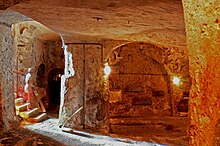Catacombs in Malta
The catacombs on Malta are three different underground, ancient burial systems on the main island of the Mediterranean archipelago, which show traces of use in Christian times. Their origins may already be in the Hellenistic era, but at the latest they were created in the Roman - Byzantine period. Originally only simple grave holes were carved into the rocky subsoil, over time more complex systems of chambers and antechambers emerged. It is characteristic of Malta that the catacombs were mostly family burial sites.
The catacombs are not identical to the Maltese rock tombs from prehistoric times (for example Xemxija near Mistra), which are to be regarded as the forerunners of the Maltese temples.
The catacomb complexes
St. Paul's Catacombs
The St. Paul's Catacombs are located in Rabat . They were created around the year 350 and extend over the previously known 1.5 square kilometers . About 1,400 dead have been buried here over the years. All of them have since been outsourced. St. Paul's Catacombs are open to the public and can be viewed after purchasing a ticket. In the catacombs you will find, among other things, so-called agap tables .
St. Agatha's Catacombs
The St. Agatha's Catacombs are also in Rabat. Their origins can be dated to around the year 200 and they are similar in size to St. Paul's Catacombs. Both underground networks are electrically lit, but they are only accessible as part of guided tours at fixed times. Saint Agatha is said to have hidden in these corridors around 248 , hence the name. The St. Agatha's Catacombs, of which only a small part can be visited, are adorned with small altars, agapetic tables and around 32 colorful murals made between 1200 and 1480, several of which are badly damaged. Two of them even go back to the fourth century.
Salina Catacombs
The Salina Catacombs are located on the main island of Malta in the northwest near the salt pans . They are within walking distance from Bugibba or Qawra . As with most catacombs in Malta, there is a small church (Annunciation Church) in the immediate vicinity. The Salina Bay's Catacombs are the only burial tunnels in the archipelago that are partially visible from the surface. These are most likely individual family graves. Each catacomb has its own entrance. But they are, so to speak, next door to each other and usually have several sarcophagi. The sarcophagi, which are individually carved out of the rock and partially merge with the rock face on one side, have a stair-like stone cushion at the head end with two circular recesses. It is believed that the heads of the deceased were placed in these hollows. It is unusual that sarcophagi exist almost exclusively for two people. At the upper edge of the stone sarcophagi and, if given, on the rock walls, traces of recesses can be seen, which indicate that a coffin plate about five centimeters thick must once have closed these sarcophagi. On a sarcophagus you can still see the recess for a wooden beam placed in the middle of the longitudinal axis below the upper edge, which prevents the stone slab from falling into the coffin when the stone slab is pushed over it.
literature
- Mario Buhagiar: Late Roman and Byzantine Catacombs and Related Burial Places in the Maltese Islands . BAR Oxford, 1986. ISBN 0860543897 (engl.)

